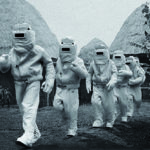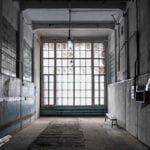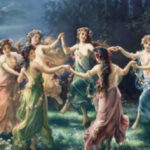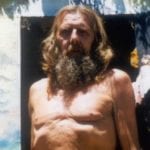 Weird Stuff
Weird Stuff  Weird Stuff
Weird Stuff  Our World
Our World 10 Ways Your Christmas Tree Is More Lit Than You Think
 Movies and TV
Movies and TV The 10 Coolest Stars to Set Sail on The Love Boat
 History
History 10 Things You Didn’t Know About the American National Anthem
 Technology
Technology Top 10 Everyday Tech Buzzwords That Hide a Darker Past
 Humans
Humans 10 Everyday Human Behaviors That Are Actually Survival Instincts
 Animals
Animals 10 Animals That Humiliated and Harmed Historical Leaders
 History
History 10 Most Influential Protests in Modern History
 Creepy
Creepy 10 More Representations of Death from Myth, Legend, and Folktale
 Technology
Technology 10 Scientific Breakthroughs of 2025 That’ll Change Everything
 Weird Stuff
Weird Stuff Ten Bizarre Facts About The Doge Meme
 Our World
Our World 10 Ways Your Christmas Tree Is More Lit Than You Think
 Movies and TV
Movies and TV The 10 Coolest Stars to Set Sail on The Love Boat
Who's Behind Listverse?

Jamie Frater
Head Editor
Jamie founded Listverse due to an insatiable desire to share fascinating, obscure, and bizarre facts. He has been a guest speaker on numerous national radio and television stations and is a five time published author.
More About Us History
History 10 Things You Didn’t Know About the American National Anthem
 Technology
Technology Top 10 Everyday Tech Buzzwords That Hide a Darker Past
 Humans
Humans 10 Everyday Human Behaviors That Are Actually Survival Instincts
 Animals
Animals 10 Animals That Humiliated and Harmed Historical Leaders
 History
History 10 Most Influential Protests in Modern History
 Creepy
Creepy 10 More Representations of Death from Myth, Legend, and Folktale
 Technology
Technology 10 Scientific Breakthroughs of 2025 That’ll Change Everything
20 More Fruits You Probably Don’t Know
I love fruit and I clearly just can’t get enough of them. When I try to imagine what one of these odd fruits taste like, it’s almost like trying to imagine a new color. I just can’t seem to wrap my mind around something I have never experienced, but that does not mean that I won’t try to experience as many as I possibly can in my lifetime. So, on account of all the omissions that were listed on the previous top 20 fruits you probably don’t know, I decided to include them and make the rest of the entries a bit more global. There are hundreds of fruits out there, but as I can’t carry on writing lists about all of them, I have settled for a few that I had never heard of and found interesting. Once again, I have not written this list in any special order, but decided on giving the number 1 spot to the most repeated omission.
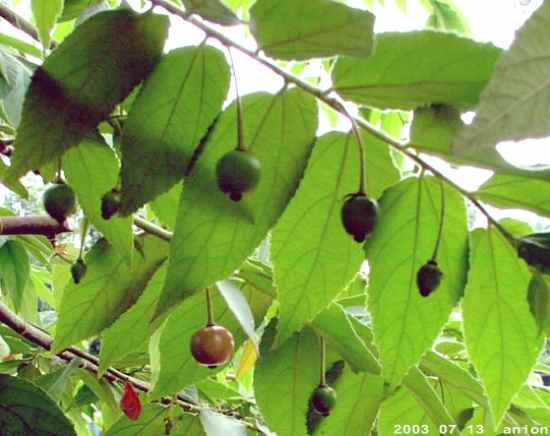
Even though I had never heard of a strawberry tree in my life, the name should be familiar to many of you. What you probably don’t realize is that there are actually three completely different species of trees known as strawberry trees, and they are found on three completely different continents.
So, starting in the far West we have the Muntingia strawberry tree, native to Southern Mexico, the Caribbean, Central America, Peru and Bolivia, also known as the Jamaican cherry or the Panama berry. The tree produces a light red fruit that is about 1.5 cm in diameter. It is sweet and juicy and can be eaten as is, or be cooked into jams.
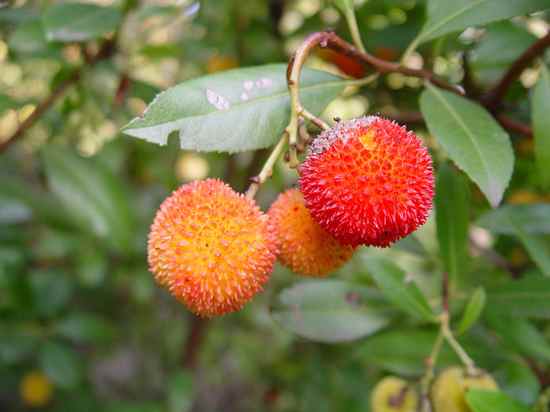
Next we jump across to Europe where we can find the Arbutus strawberry tree, native to the Mediterranean regions, France and Ireland. Due to its strange presence in Ireland, it is sometimes referred to as the Killarney strawberry tree. It bears red fruit which are about 1cm – 2cm in diameter and have a rough surface. They tend not to be eaten raw, as they have a bland mealy taste, but are often used to make jams and liqueurs.
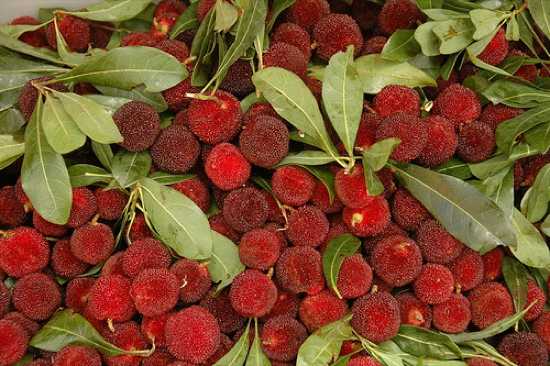
Finally we jump across to Asia, where we find the Myrica strawberry tree, also known as the Chinese strawberry tree. It is native to China but has also naturalized in Taiwan, Japan, Korea and the Philippines. The fruit can range from white to purple but are typically bright red. They have a rough outer surface, a sweet but tart taste, and a single seed at the centre. They are often eaten fresh, but can also be canned, dried or fermented. The juice has recently been commercialized and trademarked as Yumberry juice.
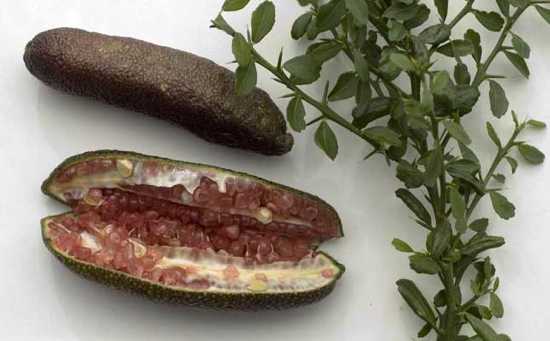
Even though citrus fruits are known to be quite common, only a very small percentage are well known to all of us (orange, lemon, lime, naartjie and grapefruit) with only a few other exceptions. What most of you probably don’t know is that there are over 100 different varieties of citrus fruits, and the finger lime is just one of those lesser known examples. The finger lime is native to the subtropical rain forests and dry forests of Australia, and can be found commonly in New South Wales and Queensland. The fruit is cylindrical and about 6 – 10 cm in length. This fruit has the widest color variations of any citrus and can be found in yellow, green, brown, orange, red, purple and black. The segments have large juicy vesicles that pop the tangy flavor into your mouth.
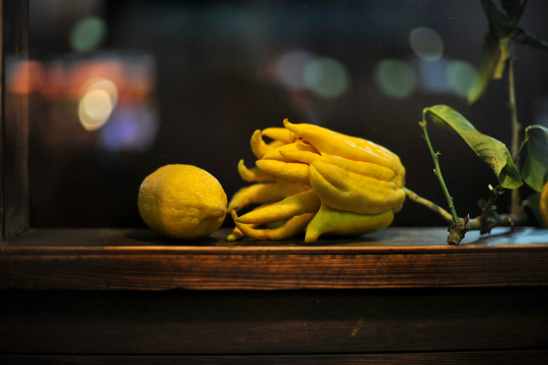
This is another fascinating citrus fruit that very few of you probably know. The Buddha’s hand or fingered citron is native to North East India and China. Its flowers are tainted purple and grow in clusters. The fruit has a thick peel, with little or no acidic flesh inside. The fruit with closed “fingers” are often given as an offering at Buddhist temples, and symbolizes hands in prayer. The fruit is mainly sliced thinly and eaten as is or sprinkled over food, since the pith (white stuff) inside the fingers isn’t bitter like in most citrus fruits, or it is used for the zest.

The Medlar is a fruit native to South West Asia and Eastern Europe, and is very popular on the coasts of Turkey. The fruit has been cultivated for over 3000 years, but has a short life span of only 30 – 50 years. The fruit has a red brown color and is about 3-4 cm in diameter, with 5 -6 long sepals at the bottom end. The fresh fruit is very hard and acidic and is softened by frost or naturally over time when picked off the tree. When softening starts the skin quickly turns brown and wrinkles, and the inside of the fruit softens considerably, leaving it with the taste and texture of apple sauce.
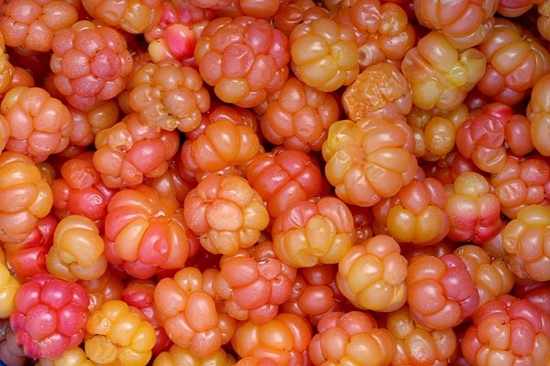
The cloudberry is an amber colored fruit, native to the Alpine and Arctic tundra as well as boreal forests. The plant grows 15-25cm tall and produces soft, juicy, segmented berries. If eaten fresh, the berries have a very distinct tart taste, and if eaten over ripe, they have a creamy taste, like yogurt, and become sweeter. Cloudberries are often cooked into jams and jellies, and in some Nordic countries, a traditional liqueur like Lakkalikööri (a Finnish liqueur) is made from them.
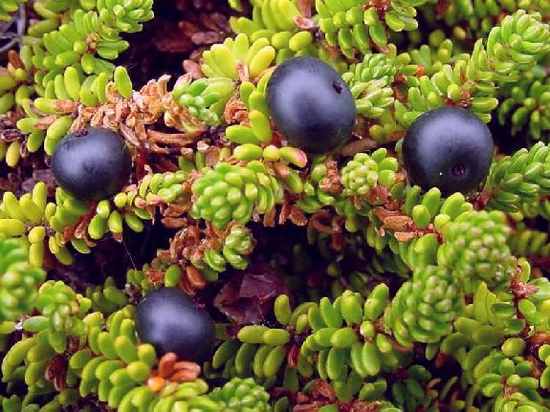
The crowberry is a small dwarfed evergreen shrub that grows best in temperate to subarctic conditions. The fruit are small berries, slightly larger than bearberries, and similar in appearance to the blueberry. These berries keep well in cold weather and can be picked in the autumn and stored for the winter. They make up a vital part of the Inuit diet, and provide a juicy sweet flavor.
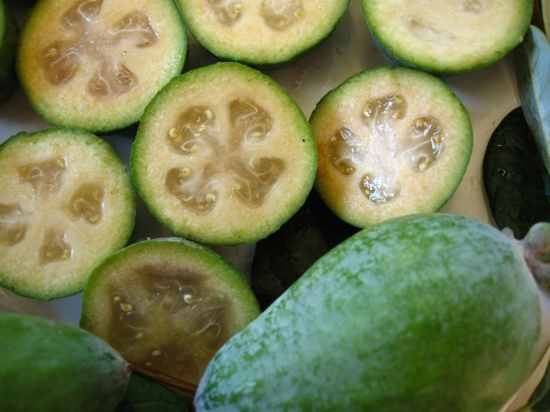
The feijoa is a fruiting tree in the myrtle family and is native to Brazil, Uruguay, Colombia and northern Argentina. It is cultivated as a fruit tree in New Zealand and is grown as an ornamental plant in Australia. Other common names for this fruit include pineapple guava and the guava stein. The fruit is made up of a soft gelatinous seed pulp (similar to tomatoes) and slightly gritty dense flesh closer to the peel. The fruit is very soft and juicy and can be scooped out of the skin with a spoon or sucked out directly with your mouth. It is said to taste similar to a combination of guava, strawberry and pineapple.
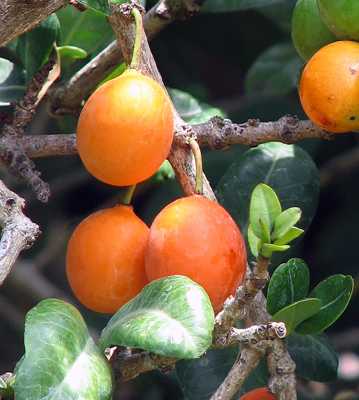
Imbe, also known as the African mongostein is a wide spread plant that can be found in tropical areas of Africa, From the Ivory Coast to South Africa. This evergreen tree bears small thin skinned, bright orange berries that grow to about 2-3 cm in diameter. The fruit tastes pleasantly sweet but has an acidic after taste, and has one large seed at the centre of the fruit. The fruit is mostly consumed fresh but can be used to flavor wines and liqueurs. The fresh berries are infamous for their hated staining power.
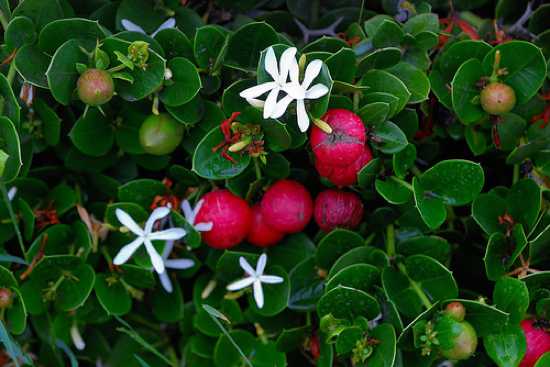
The Natal plum is a small tree or shrub native to South Africa. The fruit is also known as the large Num-Num in Zulu, and as the Noem-noem in Afrikaans. It is commonly found along the Eastern Cape coast line and is also common in Natal. The fruit is the only edible portion of the plant, as the rest is poisonous. The fruit is slightly drooped, plump and crimson in color. They can be eaten raw, or cooked into pies, jellies, jams and liqueurs. The fruit has a pleasant, sweet taste, but is still not commonly eaten or cultivated for retail.
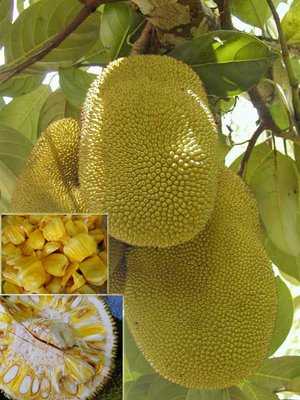
The Jack fruit is the largest tree-borne fruit, strangely related to mulberries, and is native to Southern and South-Eastern Asia. It is the national fruit of Bangladesh, but is also cultivated in South America, throughout the Caribbean, and can even be found in East African countries, such as Uganda and Mauritius. A single fruit can weigh as much as 36 kg and can reach up to 50cm in diameter. The taste of the Jack fruit is very starchy and it is a good source of dietary fibre. There are a few different varieties of jack fruit, and they range from the larger, harder fruit, which tastes similar to unripe bananas, to the smaller varieties, which are much softer inside and have a much sweeter taste.
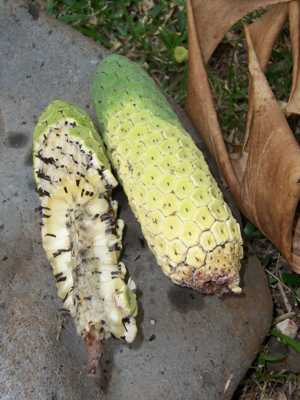
The delicious monster is grown as an ornamental plant across the world, but not everyone knows that it bearss delicious fruit. Other common names include Cheese plant, Fruit salad plant and Mexican bread fruit. The fruit grows to between 25-30 cm long with a diameter of 3-4 cm, and it looks similar to a green ear of corn. It has green “scales” all along the outside of the unripe fruit, which lifts up as the fruit ripens. Underneath is the edible flesh, which is similar to pineapple in texture and tastes like a combination of pineapple and jack fruit.
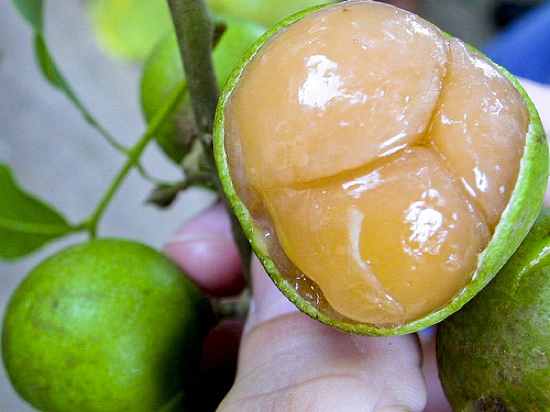
Honeyberry, also known as Spanish lime, Mamoncillo, limoncillo or Guiseps has naturalized over all the tropics and is very common in Central and South America, and some tropical areas of Africa. The fruit is green when ripe and has a large edible seed coat inside. The whole fruit is traditionally placed in the mouth, the skin is bitten and juices sucked out. It is said to taste similar to a cross between a Lychee and a lime, but can have quite a tart taste.
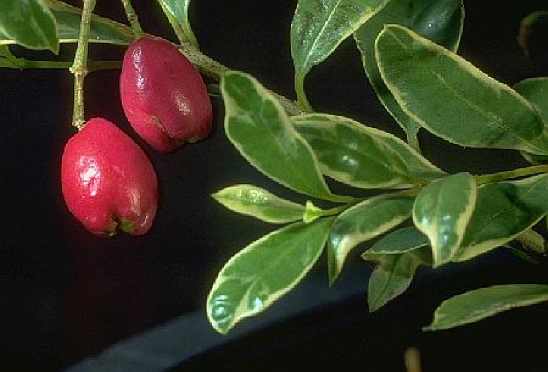
The rose apple, also known as wax apple, pamarosa, lillypilly and satin ash, is a collection of about 1100 species that fall under the myrtle family. They can be found in some areas in Africa, through to Southern Asia and throughout the Pacific. Many of these species produce fruit, and in this edition we will look specifically at the Syzygium samarangense, which bears bell shaped fruit that can vary in color, ranging from light pink, to purple, to bright red. The fruit starts out as a small ball which puffs out as the fruit ripens. They tend to smell and taste slightly rosy, hence the name, and they have a flesh to juice ratio similar to a watermelon.

The black sapote is native to Mexico and south to Colombia, and is also known as the chocolate pudding plant. The tree can grow up to 25m high and is very frost sensitive. The fruit are green on the tree and about the size of an apple. When they ripen, they shrivel and turn a brown color. The inside of the fruit is a similar consistency and taste of chocolate pudding. The fruit can be eaten raw and is often used as a chocolate substitute, or can be eaten with some orange juice and brandy. It is low in fat and high in calcium, phosphorus, iron and vitamin C. One fruit contains over 4 times more vitamin C than an orange.
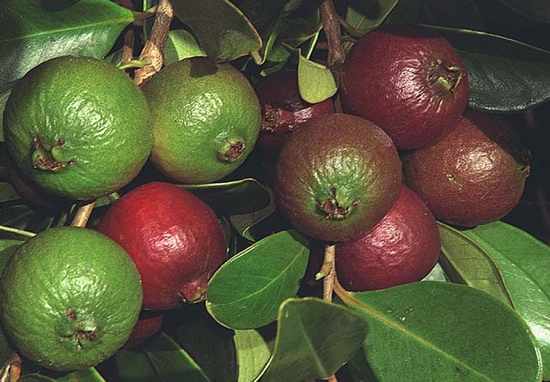
The strawberry guava, also known as the Cattley guava after notable horticulturist Sir William Cattley or the Peruvian guava, is native to Brazil. The fruit is similar in size to guavas and can be eaten by cutting it in half and scooping out the insides, or it can simply be bitten and the contents sucked out. Strawberry guavas taste like a combination of passion fruit and strawberry, and the edible skin tastes similar to rose petals, but is usually not eaten.
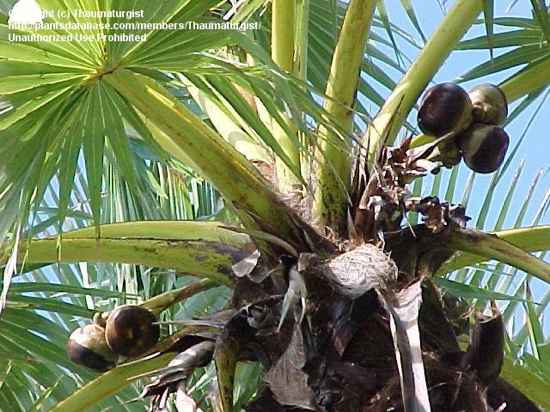
The sugar palm, also known as toddy palm or the Cambodian palm, is native to South and Southeast Asia. The tree is a large palm, which can grow up to 30m, has a large fan canopy and can live up to 100 years. The fruit can be up to 10cm in diameter and has a husk. The top of the fruit needs to be cut off to reveal juicy, gelatinous seed sockets. The fruit has a taste similar to lychees but is a little less sweet.

Saguaro is a huge cactus that is native to the Sonoran desert in Arizona, the Mexican state of Sonora and a very small part of Baja California. Saguaros have a very long life span, and it can take up to 70 years just to grow one arm. If the flowers are properly pollinated, the fruit will contain thousands of tiny black seeds, in between a mesh of sweet tasting connective tissue. The fruit is delicious and highly prized by local people.
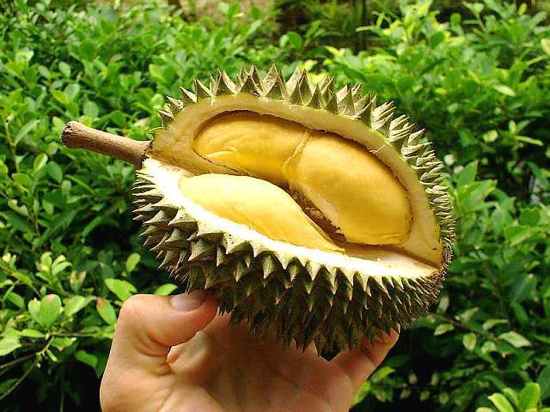
The Durian is a large fruit that is highly revered throughout Asia and is native to Brunei, Malaysia and Indonesia. It is well known as the king of the fruits and can become up to 30cm long with an average mass of 1 to 2 kg. The flesh, inside the spiny outer peel, releases a very pungent smell (sometimes likened to that of a rotting corpse) that can even penetrate through the skin, causing the fruit to be banned from many public transport systems. The inside flesh can be either pale yellow or red, depending on the species. The smell released can either evoke feelings of intense appreciation by local people, or an intense disgust for people that are not familiar with the fruit. The smell has been described as a combination of turpentine, gym socks and rotten onions. Surprisingly the taste of the fruit makes a complete contrast from the smell, and the taste has been described by naturalist Alfred Russel Wallace as “a rich custard highly flavored with almonds”. The fruit can be eaten in various levels of ripeness and even the seeds can be eaten when cooked.
